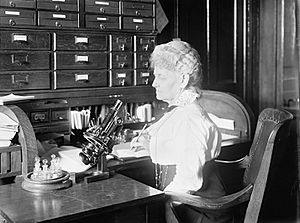Flora Wambaugh Patterson facts for kids
Quick facts for kids
Flora Wambaugh Patterson
|
|
|---|---|

Patterson at microscope
|
|
| Born | 1847 |
| Died | 1928 |
| Nationality | American |
| Alma mater | |
| Occupation | Plant pathologist |
Flora Wambaugh Patterson (1847–1928) was an amazing American scientist. She was a mycologist, which means she studied fungi like mushrooms and molds. Flora was the very first female plant pathologist hired by the United States Department of Agriculture (USDA). For nearly 30 years, she managed the US National Fungus Collections. She made this collection much bigger and helped guide its research. She also found or helped identify many important fungal diseases that affect plants.
Contents
Who Was Flora Wambaugh Patterson?
Flora Wambaugh Patterson was a groundbreaking scientist. She dedicated her life to understanding and fighting plant diseases caused by fungi. Her work helped protect crops and forests across the United States.
Early Life and Education
Flora Wambaugh was born in Columbus, Ohio, in 1847. Her parents were Sarah Sells Wambaugh and A. B. Wambaugh, a Methodist minister. Even as a child, Flora loved studying fungi as a hobby.
She went to Antioch College in Ohio and earned her first degree in 1865. Later, she earned two master's degrees from Cincinnati Wesleyan College. In 1869, Flora married Captain Edwin Patterson and took his last name. They had two children, and Flora worked to help support her family.
After her husband passed away, Patterson continued her studies. She attended the State University of Iowa. In 1892 or 1893, she planned to transfer to Yale University. However, Yale would not accept her because she was a woman. Instead, she moved to Cambridge, Massachusetts. There, she began studying at Radcliffe College and worked at the Gray Herbarium at Harvard.
A Pioneer at the USDA
In 1895, Flora Patterson joined the USDA as a plant pathologist. A plant pathologist is a scientist who studies plant diseases. She was hired by Beverly T. Galloway, alongside another scientist named Franklin Sumner Earle.
During her almost 30 years at the USDA, Patterson made a huge impact. She increased the size of the U.S. National Fungus Collections by a lot. It grew from 19,000 to 115,000 reference specimens. These specimens are like a library of fungi, helping scientists identify new species.
Fighting Plant Diseases
Flora Patterson identified many new types of fungi. Some of these fungi caused serious plant diseases. For example, she found the fungus that causes pineapple rot (Thielaviopsis paradoxa). She also identified the fungus behind peach leaf curl (Taphrina). Another important discovery was the fungus causing "witches' broom" on bamboo (Loculistroma bambusae). This was a completely new type of fungus!
Patterson was also in charge of finding new fungal diseases. She played a key role in identifying the chestnut blight. This disease sadly wiped out most of the chestnut trees in eastern North America. She also helped identify the potato wart disease caused by Synchytrium endobioticum.
Protecting Plants: The Cherry Tree Story
Flora Patterson was involved in a famous event: Japan's gift of cherry trees to the United States. The first shipment of these beautiful cherry trees arrived infected with many insects and diseases. Patterson helped identify these problems. Because of her findings, the first shipment of trees had to be destroyed to protect American plants.
This incident, along with others, led to the creation of the Plant Quarantine Act of 1912. This important law aimed to stop harmful diseases and insects from entering the country.
Her Legacy
Flora Patterson continued her important work at the USDA until she retired at age 75. She then lived with one of her sons in New York City. She passed away at the age of 80, leaving behind a legacy of protecting plant health.
See also
 In Spanish: Flora Wambaugh Patterson para niños
In Spanish: Flora Wambaugh Patterson para niños

